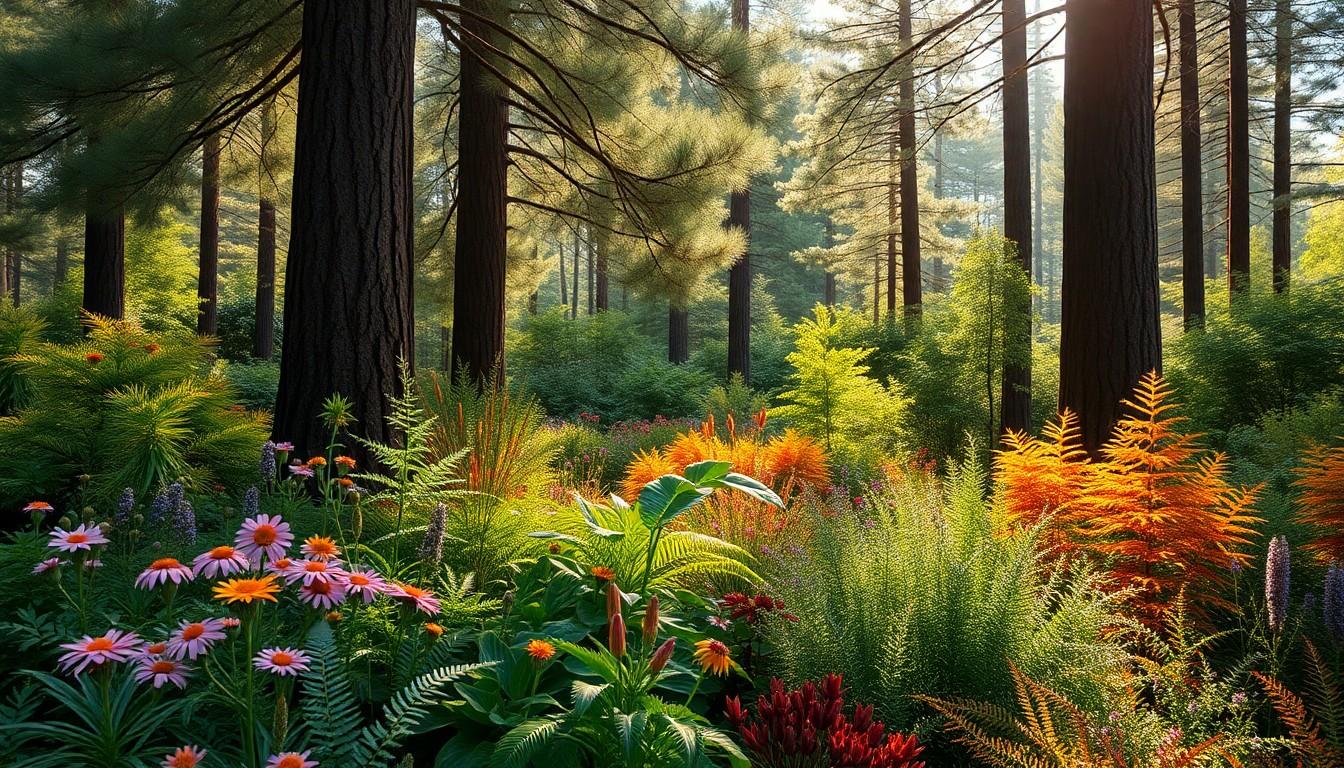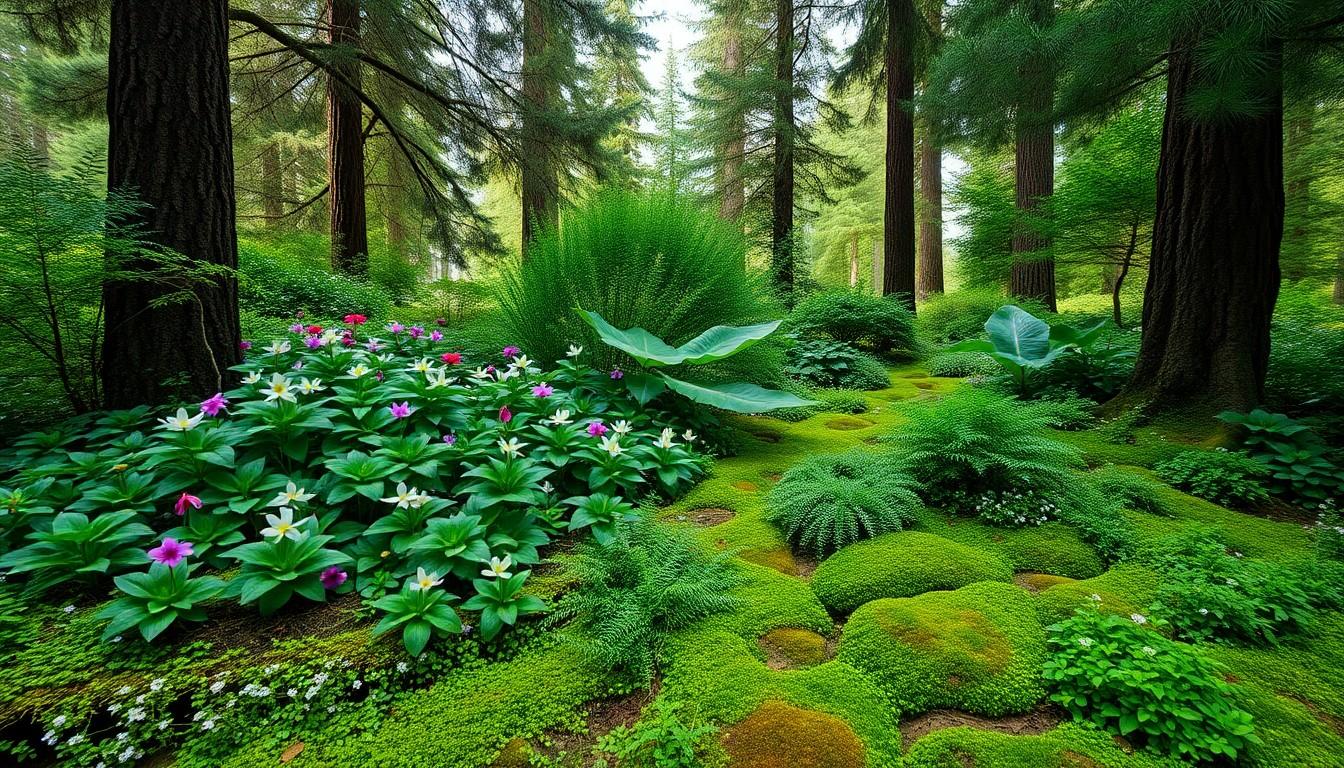Pine trees are like the towering guardians of the forest, casting their shade over the ground and creating a unique ecosystem beneath their branches. But did you know that this cozy underworld is home to a variety of native plants just waiting to steal the show? While many gardeners shy away from these shaded spots, they might be missing out on a botanical treasure trove.
Imagine a vibrant patch of wildflowers peeking out from under those prickly needles or a lush carpet of ferns swaying gently in the breeze. Not only do these native plants thrive in the piney shade, but they also play a crucial role in supporting local wildlife. So why not embrace the quirky charm of these shade-loving plants? It’s time to dig deeper and discover the hidden gems that can transform your piney paradise into a flourishing haven.
Overview of Native Plants
Pine trees create distinct environments that foster various native plants. Shade-tolerant species often flourish beneath these evergreens. Notable examples include wildflowers like trillium and celandine poppy, which thrive in low-light conditions. Lush ferns such as Christmas ferns and ostrich ferns also prefer the cool, moist undergrowth that pine forests provide.
Ground cover plants like creeping thyme and wild ginger excel under pine canopies. These plant types not only beautify the area but also help prevent soil erosion. Various species of moss contribute to the rich biodiversity found in these settings. They add texture and depth to the forest floor while retaining moisture.
Wildlife benefits from the native plants beneath pine trees. Bird species often seek refuge among the low vegetation, finding food and shelter in this unique habitat. Additionally, pollinators like bees and butterflies play crucial roles in the reproduction of many of these plants.
Gardening enthusiasts can enhance their landscapes by incorporating these native plants into their designs. Selecting species adapted to the specific conditions under pine trees promotes sustainability. Growing a diverse group of native plants supports local ecosystems, promoting a healthy balance between flora and fauna.
Understanding the importance of this ecosystem encourages exploration of plant options. Each plant holds significance in maintaining the biodiversity of shaded areas under pine trees. By focusing on native selections, gardeners not only create beauty but also foster environmental benefits.
Benefits of Native Plants Under Pine Trees

Native plants under pine trees offer numerous ecological advantages. These species thrive in the unique environment created by the trees, promoting biodiversity and enhancing ecosystem stability.
Erosion Control
Native plants provide significant erosion control. Their robust root systems stabilize soil, preventing it from washing away during heavy rains. Ground covers like creeping thyme and wild ginger thrive under pine trees. These plants not only hold the soil in place but also reduce runoff, maintaining soil moisture. The dense foliage limits weed growth, contributing to a healthy undergrowth. This natural barrier promotes the retention of nutrients, fostering a stable habitat for other organisms.
Wildlife Habitat
Pine tree areas serve as strong wildlife habitats. Diverse native plants attract and support various wildlife species, including birds, insects, and small mammals. For instance, vibrant wildflowers and lush ferns create shelter and food sources. Pollinators such as bees and butterflies find essential resources among these plants. Additionally, the shaded environment provides refuge for birds, offering nesting sites and protection from predators. This flourishing ecosystem enhances biodiversity while supporting the local flora and fauna.
Popular Native Plants That Grow Under Pine Trees
Native plants create a vibrant ecosystem beneath pine trees. The variety of shade-tolerant species thrives in this unique environment.
Groundcovers
Groundcovers provide excellent options for shaded areas under pine trees. Creeping thyme serves as a fragrant, low-growing option that attracts pollinators. Wild ginger establishes a dense mat, preventing soil erosion while offering lush foliage. Additionally, various moss species contribute to moisture retention and enhance the natural beauty of the landscape. These groundcovers not only foster a healthy undergrowth but also limit weed growth, allowing the ecosystem to flourish effectively.
Shrubs
Shrubs play a crucial role in enhancing the underfoot environment beneath pine trees. Blue hollies grow well in shaded locations, providing both structure and visual interest. Another excellent choice is the native azalea, which blooms with striking flowers and attracts hummingbirds. Additionally, viburnums can fill the area with their lush foliage and fragrant flowers, offering food and shelter for local wildlife. Incorporating these shrubs adds layers of diversity, enriching the ecosystem’s overall health.
Perennials
Perennials bring vibrant colors and textures to shaded spaces under pine trees. Trillium, with its stunning blooms, flourishes in cooler, damp conditions, complementing the overall landscape. Celandine poppies provide early spring color and attract various pollinators, contributing to biodiversity. Both Christmas ferns and ostrich ferns thrive in these shaded areas, adding lush greenery throughout the growing season. By selecting perennials suited for the shade, gardeners can create a dynamic and sustainable garden that supports local ecosystems.
Selecting the Right Plants
Understanding soil conditions and light requirements is essential when selecting native plants that grow under pine trees. The right choices create a thriving and sustainable ecosystem.
Soil Conditions
Soil beneath pine trees tends to be acidic due to fallen needles. This acidity encourages specific native plants to flourish. Testing soil pH can provide valuable insights before planting. Many shade-tolerant species thrive in well-drained, loamy soil with organic matter. Incorporating compost enhances soil nutrition, supporting plant growth. Additionally, some plants, like ferns and wild ginger, adapt well to the moisture-retentive qualities of this soil type. Evaluate drainage to avoid waterlogged conditions, as excess moisture can harm certain plants.
Light Requirements
Light availability varies significantly under pine trees. Dense pine canopies offer filtered sunlight, while some areas receive more direct light. Native plants often adapted to these conditions. For example, trillium and celandine poppy prefer dappled light, thriving in cooler, shaded spots. Meanwhile, certain shrubs like native azaleas enjoy brighter conditions near edges or clearings. Understanding the specific light preferences of each plant type ensures successful growth and a balanced ecosystem. Observing sun patterns will provide insight into choosing the most suitable plants.
Maintenance and Care Tips
Choosing the right native plants requires understanding their maintenance needs. Watering is crucial, especially during dry spells. Native plants generally adapt well to local rainfall, but supplemental watering keeps them healthy, especially in their establishment phase.
Mulching benefits the undergrowth by retaining moisture and suppressing weeds. Organic materials like shredded leaves or bark chips work best under pine trees. Observing soil condition is equally important, as the acidic nature of pine needle litter influences plant health. Regular soil testing ensures nutrient availability.
Pruning encourages healthy growth in shrubs and can enhance flower production in perennials. Timing for pruning varies; spring flowering plants should be pruned right after blooming while summer bloomers should be pruned in early spring. Regular deadheading of flowers keeps the plants looking tidy and can encourage longer blooming periods.
Monitoring for pests and diseases contributes to the overall wellbeing of the native plants. Regular inspections help catch issues early. Integrated pest management strategies work effectively without harming beneficial insects.
Encouraging biodiversity thrives under pine trees. Planting a mix of ground covers, shrubs, and perennials creates a balanced ecosystem. Incorporating native species attracts beneficial pollinators, enriching the habitat while fostering growth.
Adapting care practices to the specific plant species ensures sustainability. Understanding individual light and moisture requirements leads to successful growth. Implementing these maintenance tips not only fosters a vibrant garden but supports the ecological health of shaded areas beneath pine trees.
Conclusion
Embracing native plants that thrive under pine trees offers a unique opportunity to enhance gardens while supporting local ecosystems. These plants not only beautify shaded areas but also play a crucial role in promoting biodiversity. By selecting the right species and understanding their specific needs gardeners can create vibrant landscapes that attract wildlife and prevent soil erosion.
Incorporating ground covers shrubs and perennials fosters a balanced ecosystem that thrives in the cool moist conditions beneath pine canopies. With thoughtful maintenance and care these native plants can flourish providing lasting beauty and ecological benefits for years to come.

